Robin Little Wing Sigo has raised her eldest daughter, Kylie, on the Port Madison Indian Reservation since she was 2 months old. Although Kylie is biologically her cousin, Sigo was able to become her foster parent so Kylie could grow up connected to her extended family on the Kitsap Peninsula.
“It's strange for me to think that when I was born, my parents wouldn't have been afforded that privilege if they had struggles,” said Sigo, the director of the Suquamish Research & Strategic Development Department and recently retired tribal council member of nine years.
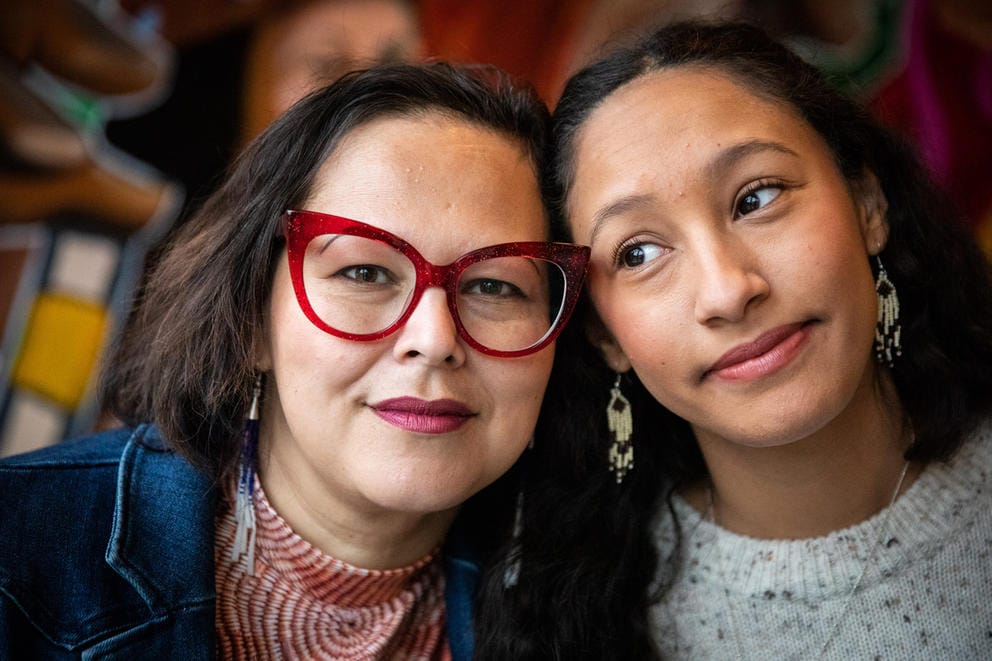
Robin Little Wing Sigo, the director of the Suquamish research & strategic development department, with her daughter Kylie Cordero at The Suquamish Tribe’s Family & Friends Center on Tuesday, Nov. 22, 2022. The Indian Child Welfare Act helped Sigo become a foster mother for Kylie, her second cousin’s daughter, ensuring Kylie could remain part of the Suquamish Tribe. The ICWA was enacted in 1978 to help keep Indigenous children in Indigenous homes, but a case before the U.S. Supreme Court could change that precedent. (Amanda Snyder/Crosscut)
Sigo doesn’t think she could’ve kept Kylie close to their family without the ICWA, the Indian Child Welfare Act. The law, established in 1978, enabled Native governments to intervene in child welfare cases involving Native children and prioritize placement with family or extended kin. The ICWA also requires child welfare departments to give Native nations notice as soon as an investigation begins into a Native family to determine if the child needs services or removal. Once a nation has notice, it can determine the best course of action for its citizens and provide support.
Because Sigo became a foster parent through the ICWA, Kylie was able to go trick-or-treating with people who know her birth mom and grandfather, and maintain connections to her community. With fewer than 1,000 Suquamish people enrolled and living on or near the reservation, the community is close.
“We’d walk into my dad's house and her biological grandpa is there too because they're both first cousins and they hang out together,” she said.
The fate of Native kids in situations like Kylie’s may be determined in the U.S. Supreme Court’s current session.
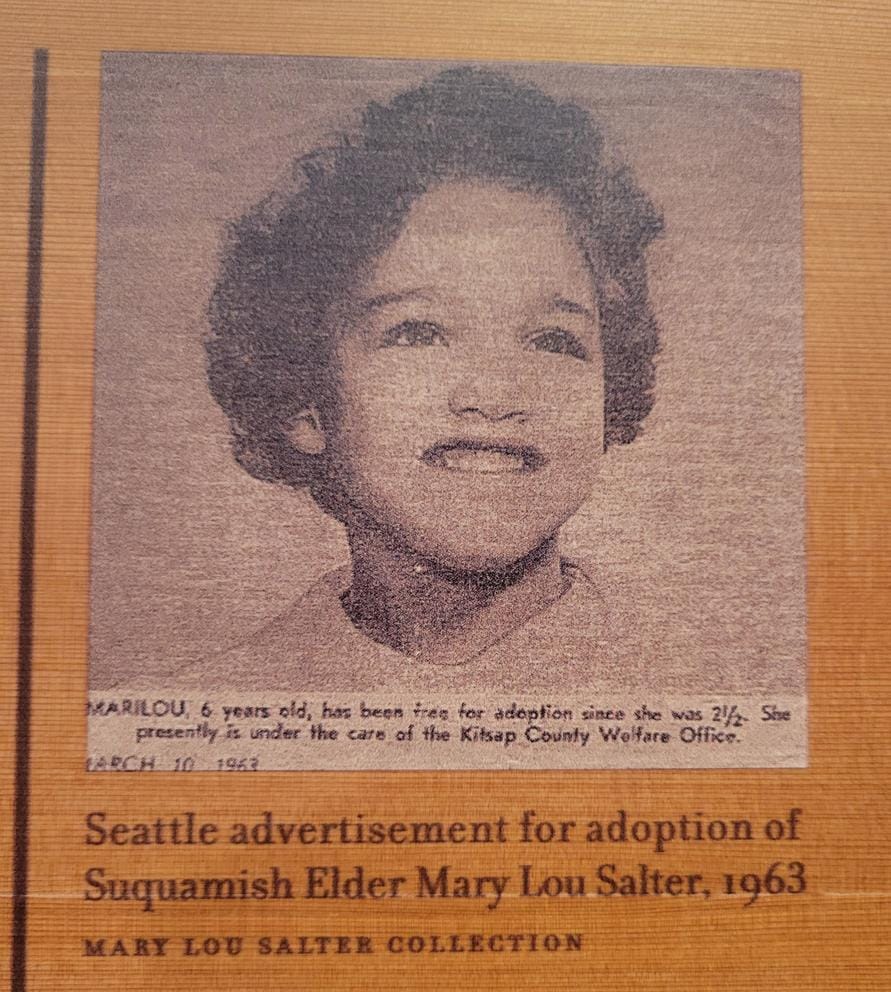
An adoption advertisement from 1963 for Suquamish Elder Mary Lou Salter. She was 6 at the time, and the text says she had been “free for adoption since she was 2 1/2.” (Courtesy of Mary Lou Salter)
The ICWA in Washington
On Nov. 9, justices heard arguments in Haaland v. Brackeen, a case that could dismantle the ICWA.
The suit, brought by seven individuals and the states of Louisiana, Texas and Indiana — backed by multibillion-dollar special interest groups — argues that the ICWA is racially discriminatory and intrudes on states’ authority to protect at-risk children. A decision is expected by June 2023.
Washington passed its own version of the ICWA in 2011 to reinforce the federal policy and strengthen relationships with the state’s child welfare system and federally recognized Native nations. Ross Hunter, secretary of the Washington State Department of Children, Youth, and Families, said that whatever the ruling, his office will work collaboratively with tribes to come up with an appropriate formal response. If the ICWA is deemed unconstitutional on the basis of racial discrimination, both the state and federal laws will no longer be enforcible.
Before the ICWA, Washington’s adoption rate was 19 times higher and the foster care placement rate was 10 times higher for Native kids than non-Natives. Since the ICWA those numbers have dropped tremendously, but Indigenous children are still overrepresented in Washington's child welfare systems, with the sixth-highest rate of removal among the 50 states, according to the National Indian Child Welfare Association. Native children are almost three times more likely to be in state care nationally, according to the National Council of Juvenile and Family Court Judges.
Although the Native child welfare system has a way to go before it is equitable or unbiased, “tribal entities would be further marginalized” without the ICWA, said Judge John Romero, immediate past president of the National Council of Juvenile and Family Court Judges and presiding judge of the Children’s Court Division of the Second Judicial District Court in Albuquerque, New Mexico.
“The voices of the tribes, the voices of the parents, the extended family members, and very importantly, the wishes and desires of the children would go unheard, to their detriment to the detriment of the tribal entities, and quite frankly, the detriment of our whole country,” he said.
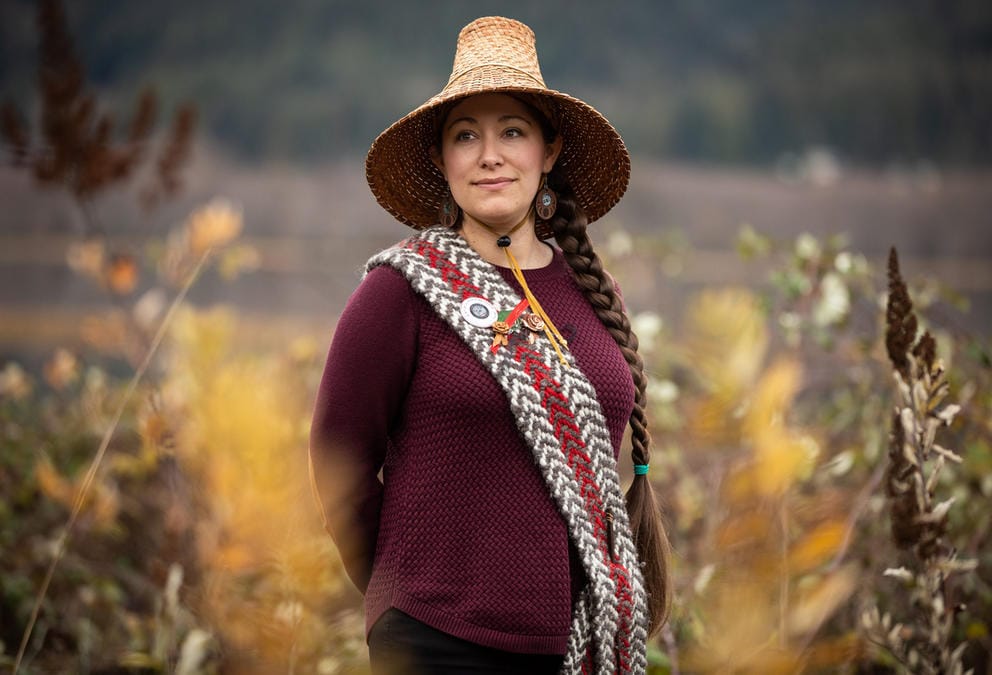
Loni Greninger, Jamestown S’Klallam Tribe's social & community services department director and tribal vice chair, was an influential part of creating the Indian Child Welfare Act in Clallam County Superior Court. Greninger worked with the Washington State Department of Social & Health Services (DSHS) as an Office of Indian Policy Regional Manager, and then as a Statewide Tribal Liaison. (Amanda Snyder/Crosscut)
Historical discrimination
The overrepresentation of Native children in the child welfare system is a direct result of the federal government’s legacy of discrimination against Indigenous people. In 1869, the federal government forcibly removed Native children from their families and homelands and placed them in boarding schools to intentionally destroy family and cultural ties to assimilate them into white society. The children were given English names, expected to convert to Christianity, and beaten if they spoke in their Native language. School leaders also cut the children’s hair, which in many Indigenous cultures is considered sacred and part of their cultural identity, and even placed them in white families’ homes on “vacations” for a year or more at a time.
The boarding-school philosophy “kill the Indian, save the man” was cultural genocide for many. It also became literal for many Native youth who were murdered or reportedly died from sicknesses like tuberculosis and never returned home. Those who ran away or tried to hide were corralled by Indian Service employees, who often hogtied the children when they were caught and dragged them back to the boarding schools, where they continued to be abused.
“There are tribes out there who have lost generations of children, and the children are the ones that carry our traditions and our hopes and dreams forward,” said Loni Greninger, the Jamestown S'Klallam social and community services department director and tribal council vice chair. “It's absolutely devastating. You’re removing generations from us, you're removing our future from us, that we have been bound by the Creator to work toward.”
Greninger said the English language has a hard time describing the boarding-school experience. The best way to describe the hurt and pain of this loss for her is the Klallam phrase said to children, ʔaʔ nsxʷi (“ah n-swee”) meaning, “You are my very breath.”
“Think about if your very breath is taken from you, how devastating is that, and that's what these tribes are experiencing,” Greninger said. “Even taking your breath away for a season is still harmful.”
By 1926, at least 83% of Native school-age children were forced into boarding schools, many of which didn’t shut down until the 1930s. This was followed by the Indian Adoption Project in 1958, another assimilation policy that removed Indigenous children from their homes and placed them with white families. Forced adoption was considered in the “best interest” of the Native children in order to “civilize” them.
A 1966 Bureau of Indian Affairs press release reads: “One little, two little, three little Indians — and 206 more — are brightening the homes and lives of 172 American families, mostly non-Indians, who have taken the Indian waifs as their own.”
Kitsap County’s child welfare office even ran a photo of Suquamish elder Mary Lou Salter in the local newspaper in 1963 advertising her “free” for adoption since she was just two-and-a-half years old.
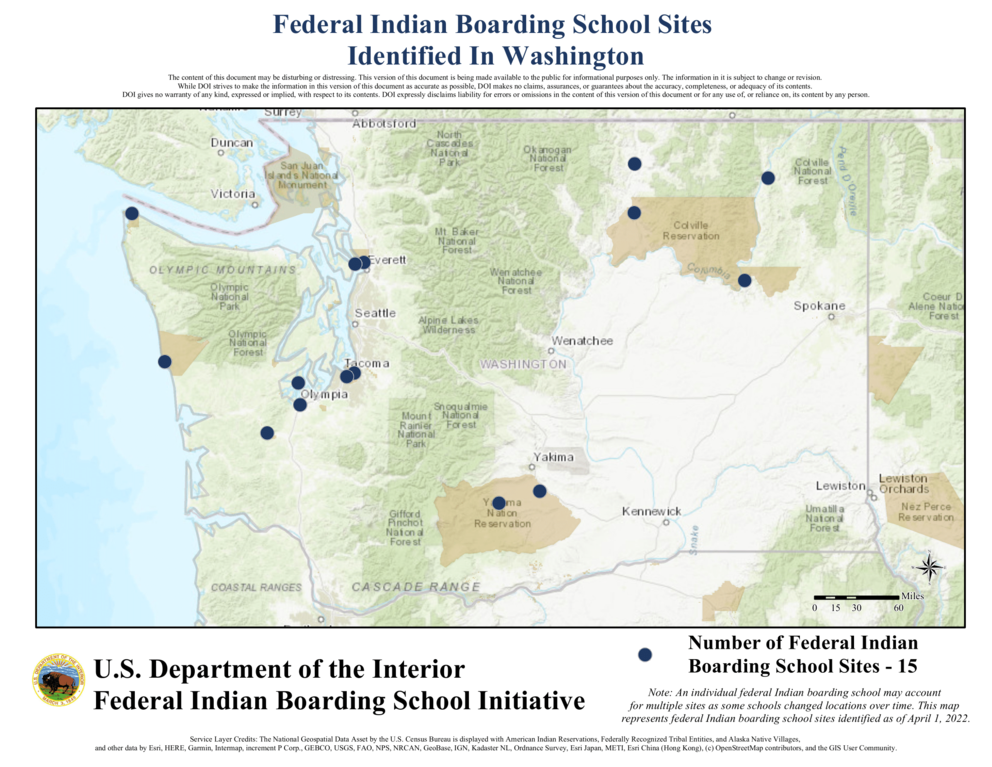
A Federal Indian Boarding School site map.
Stealing children
Native people were viewed as unfit to raise their own children, and the environment on reservations was viewed as so horrendous that no child should ever be subjected to being raised there, said Bert Hirsch, a non-Native attorney practicing Native American law for the Association on American Indian Affairs.
“If you were poor, the idea was that you were unfit to parent and your kid should be taken away,” Hirsch said. “Within the non-Indian professional community of lawyers, caseworkers, social workers and policy policymakers, that was the prevailing view.”
In 1969, Hirsch led an effort by the AAIA to survey every child placement agency in the United States, which discovered that as many as one-third of Indigenous children around the country were being removed from their homes, and 90% of those removed were being placed with non-Native families. The proof of the magnitude of the loss for Native nations is what helped to advance the ICWA.
“ICWA was created because child welfare systems were stealing children,” said Hunter of Washington’s Department of Children, Youth, and Families.
The Indian Child Welfare Act works to change this by prioritizing keeping Native children connected to their family, community and cultures.
“Research has shown that being removed from your family, from people that you love, and the people that love you and from your culture is really debilitating to children,” he said. “Children do better with relatives.
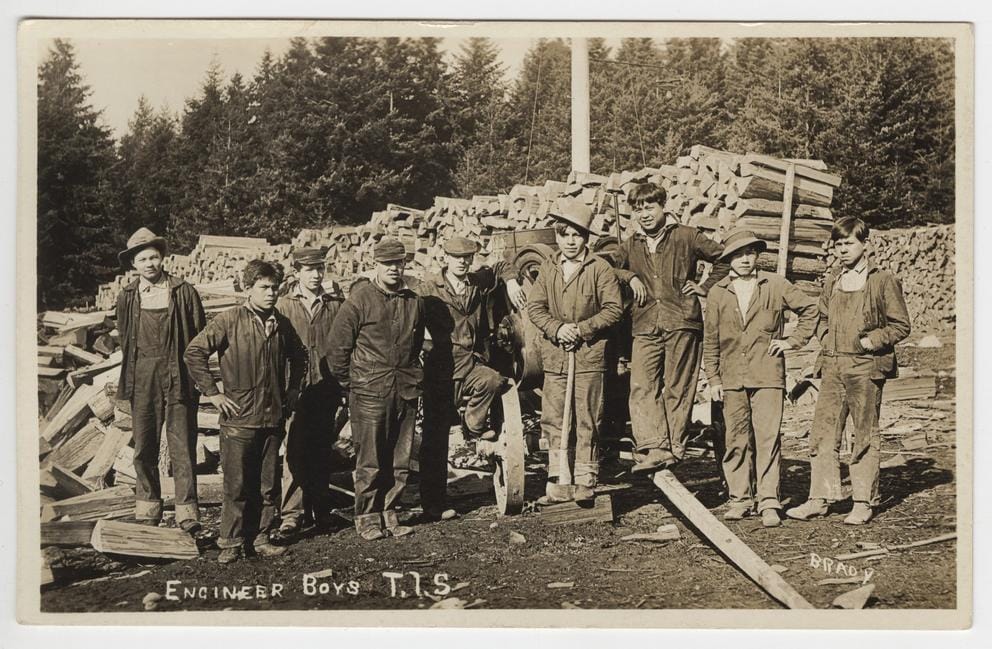
Wood chopping crew at the Tulalip Indian School, 1912. (Courtesy of MOHAI)
Gold standard
The ICWA is now considered the “gold standard” for the welfare of all children by many child-advocacy organizations, including the National CASA (Court Appointed Special Advocates) Association, the National Association of Social Workers, Casey Family Programs and the Child Welfare League of America. Hunter calls the ICWA the gold standard because it has helped set equitable best practices across all cultures and families. The ICWA has influenced kin placement for non-Native children all over the country and established a better understanding of the necessity of culturally competent and responsive services for all families and their cultures.
As a Suquamish tribal council member, Sigo said her nation helped move people into houses that the tribe owns so that a Suquamish foster family would have a big-enough space to be able to accept children. They also helped pay move-in costs for a bigger home so that a Suquamish child was able to stay with a Native family. The ICWA has even helped find Suquamish citizens who have been separated from their nation due to the many past assimilation policies and provide them with services that wouldn’t have been available to them if they hadn't found the tribal connection.
Sigo said she is grateful that the ICWA enabled her to keep Kylie connected to her birth mom and all of her extended kin and culture.
“[The ICWA] is one of the only laws that has really been reparative,” said Tleena Ives, director of tribal relations for Washington’s Department of Children, Youth, and Families and an enrolled member of the Port Gamble S’Klallam Tribe. Ives believes the ICWA is important for Indigenous communities’ continued healing from trauma related to child removals and for honoring the sovereignty of each nation and its capacity to choose what is in their citizens’ best interest.
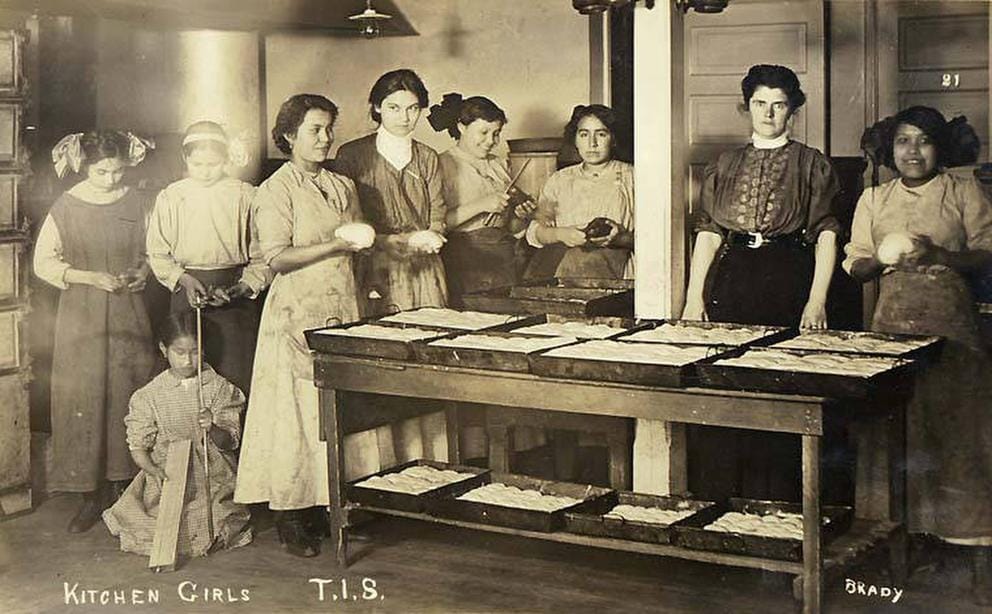
Kitchen girls at the Tulalip Indian School, 1912. Every student at the boarding school spent at least half of his or her day working in some part of the operation. Boys rotated about every six weeks among jobs as carpenter, engineer, farmer or dairyman; girls were assigned to sewing, darning, laundry and kitchen work. (Courtesy of MOHAI, 88.11.16)
Race vs. sovereign political nation
A Texas couple, Chad and Jennifer Brackeen, who are central to the case against the ICWA, decided to become foster parents and returned their first foster child because they were “difficult.” In 2016 the wealthy white Christian couple fostered a Navajo and Cherokee toddler whom they knew they would never be able to adopt due to the ICWA. “I thought a baby for 3 months would be a nice way to get our feet wet again,” Jennifer Brackeen wrote in her family blog, which has since been deleted.
When the boy’s birth parents lost all parental rights after a year, the Brackeens attempted to adopt him, but the Navajo Nation wanted the boy placed with a family on the reservation. The Brackeens were eventually able to adopt him in 2018 and are now attempting to adopt his half-sister.
Although they were able to adopt the Navajo and Cherokee toddler, the Brackeens claim that the ICWA is a race-based law and their rights as non-Native adoptive parents were violated.
“It's exactly the opposite,” Hirsch said of the Brackeen’s claims. “The tribes and their families and their kids had been denied equal protection for forever and the Indian Child Welfare Act simply established equal protection.”
“I think it's bullshit,” Hunter said when asked about the argument that the ICWA is racially discriminatory. “It's based on the membership of a nation state that has a treaty relationship with the United States of America. The law is pretty clear that it's about sovereignty. It's not about race.”
Judge Romero, past president of the National Council of Juvenile and Family Court Judges, agreed with Hunter and Hirsch.
“They're arguing that all of the placement preferences are based on racial lines and ignoring the fact that tribes are sovereign entities, and their members have rights,” he said.
Greninger, the Jamestown S'Klallam social and community services director and tribal council vice chair, first and foremost she said she identifies as a citizen of a sovereign tribal nation. The modern colonial constructions of race are much less important to her identity.
“We are politically distinct first before we are racially distinct,” Greninger said. “We are protecting what is sovereignly ours. We have a citizenship, and that citizenship is what makes our government come alive. It makes our treaty rights come alive. It makes our culture, our traditions, our arts, our language, our songs and dances, our identities, the tribe as a whole identity. We need people for it to come alive."
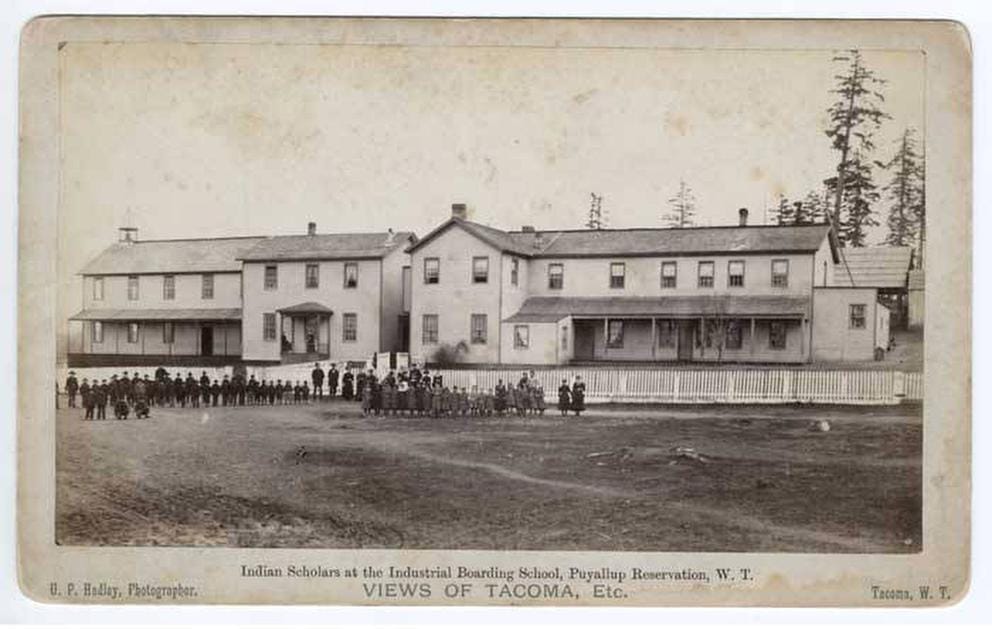
Native students at the Industrial Boarding School, Puyallup Reservation,1885. (Courtesy of MOHAI, shs3491)



